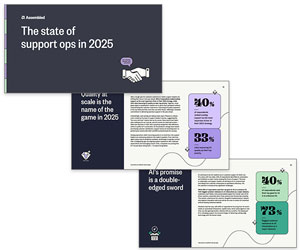Greg Aiello, an Operations Support Director, introduces us to the challenges of peak management and highlights how best to overcome them.
“Peak Management” – does this term fill you with excitement at the thought of increased business? Or does it fill you with dread due to the vast workload required?
Peak periods with high volumes of calls throughout the year are undoubtedly the most challenging time for any contact centre that is affected by holidays such as Christmas and Easter.
Yet there are also unforeseen peaks, which are even harder to navigate. “The Beast from the East” created an unexpected peak earlier this year, which caught many contact centres – especially those in the utilities sector – off-guard.
The key to success is plan, plan, plan! And where you can’t plan? Prepare for the unexpected, so you’ll never be on the back foot.
So, how do you go about planning for peaks? Where do you start? When do you start?
Below we try to answer these questions and more. So firstly…
What Do We Mean by Peak Management?
Quite simply, peak management is about how you handle spikes in workload.
In the contact centre, a spike in workload begins from the moment contact volumes exceed what is forecast and it finishes when volumes return to their expected level.
Other industries, including retail businesses, are also affected by peak periods. Retail businesses will also have spikes in workload because of an increase in customer contact.
Causes for peak periods can be split into two categories: planned and unplanned.
Planned peaks can include:
- Holiday periods such as Christmas, Easter, Valentine’s Day and Mother’s Day
- Intensive sale periods including Black Friday Sale, Cyber Week, Boxing Day Sales and January Sale
- Planned marketing campaigns for new customer offers and new technology releases
- Changes to service due to price increases and other changes to T&Cs
Unplanned peaks can include:
- Technical faults or outages
- Product recalls
- Unannounced marketing campaigns
- National crisis including epidemics, severe weather or political changes
- Negative press exposure
- Company shortcomings resulting in increased customer complaints
The priority of any business should be to ensure the customer experience does not suffer as a result of these peaks.
Effective management and prior planning can ensure a company better deals with these challenging times, with minimal difficulty and customer impact.
Challenges During Peak Periods
Unsurprisingly, there are many challenges to working through peak periods, starting with forecasting.
It’s important to understand your business, going through the historical data you have and then taking into account recent and predicted changes in your industry.
With planned peaks this is generally easier, with months in advance to plan and study, ensuring workforce optimisation can be at its best.
However, with unplanned peaks, there may be reduced data to create an accurate forecast. So, getting as much support as possible with this is essential, then plan for the worst.
To help plan for the worst, create a set of Standard Operating Procedures (SOPs). These are a set of guidelines that dictate and prioritise what should be done when contact volumes are higher (or lower) than expected.
To help plan for the worst, create a set of Standard Operating Procedures (SOPs). These are a set of guidelines that dictate and prioritise what should be done when contact volumes are higher (or lower) than expected. It may also be important to consider homeworking, if advisors cannot get into work during bad weather, which may have caused the peak in contact volumes.
Also, if employees are hired on temporary contracts, it is possible to review your staffing levels during the peak and adjust accordingly if needed.
The next stage is recruitment, which will be determined by your forecasting. It’s important that a business understands its local recruitment pool and the capabilities of its recruitment team.
The team will need to carry out their usual recruitment work in addition to recruitment for peak, which can put massive strain on their resources.
Consider taking on an additional recruitment specialist in a temporary role, joining the team a few months in advance to provide support.
Consider taking on an additional recruitment specialist in a temporary role, joining the team a few months in advance to provide support.
When the recruitment is completed, the training begins. The availability of training resource should be considered months in advance, ensuring that they have the right people and the necessary space to facilitate mass training in a limited time period.
The ability to train new employees to an acceptable standard is key – when a customer interacts with any business, they expect a consistent, first-class service.
Once in their new roles, the mass onboarding of new employees brings about a host of operational challenges, putting strain on most departments.
Be prepared in advance and ensure your tenured managers and support functions are ready and new management is brought in early enough to become immersed in the culture/behaviours and processes.
With advisors now using the software and hardware in a live environment, this can also bring about a whole other host of unforeseen issues relating to IT, which you need to be prepared for.
3 Tips to Overcome the Challenges of Peak Management
Although it is impossible to provide a guaranteed, one-size-fits-all solution to peak management, it is possible to provide you with the 3 pillars required to give you the best chance of success. Like any complicated structure, the key is in its foundations, so here they are:
1. Engage as a Team, Collaborate and Utilise Expertise
Like any challenges, peak management is best tackled as a team. Resource planners need support to build the best forecasts and schedules. Team leaders need support to tackle absenteeism in these periods. Advisors need support to stay motivated. So, try to work as a unit.
To do so, you need to come up with a robust plan. Ensure that resource planners have all the data they need, that advisors can be drafted in if required and that team morale remains high.
In order to keep morale high, you may want to create games. For example, during the Christmas peak period, why not plan a “12 days of Christmas” event, as they do at the Sitel and Vax contact centres.
Whatever you do, ensure that workload is spread appropriately, focusing on advisor and managerial areas of expertise. Then, communicate openly and frequently to ensure everyone involved has the full picture.
Utilise your tenured, more experienced employees to handle the complicated customer queries, while directing the basic transactional queries to your new starters or temporary staff.
Also, utilise your tenured, more experienced employees to handle the complicated customer queries, while directing the basic transactional queries to your new starters or temporary staff. This reduces the amount of training they require and minimises risk of customer detriment.
2. Plan for the Unexpected
Robust project planning skills are key. Know your verticals and take into account any external impacting factors that could cause peaks in contact volumes.
For example, the World Cup and Olympics can create headaches for some forecasting teams, as well as in other areas of the contact centre, if absenteeism spikes.
So, best practice is to begin planning far in advance. For example, for the Christmas peak you would begin the project planning in May. Don’t leave it until October to start the recruitment process.
Also, you must consider early, based on your resources, whether you need to hire temporary staff, move to the cloud and set up a homeworking function or outsource some of the work.
3. Ensure System Capability Is Available for Large Volumes
This should be checked in advance as part of the project planning, because it is important to ensure telephone lines and other hardware have the capacity to support influxes of customer contact.
Also, consider physical space for systems, as well as licensing restrictions for software and so forth.
Another key to ensure system capability is to utilise other areas of IT support, such as the changes to an IVR system and to set expectations of wait times or digital initiatives.
For example, you can add a message in the IVR to warn customers of the long wait time and to suggest they switch to a less busy channel for a quicker response.
Add a message in the IVR to warn customers of the long wait time and to suggest they switch to a less busy channel for a quicker response.
Even better, if your IVR is sophisticated enough, you can also offer to hold the customer’s place in the queue and for an advisor to call the customer back once they have reached the front of the queue.
Live chat can be seen as an option to enhance speed of response, but be aware this could open up a new channel for customer contact and attract a base of customers you didn’t speak to before.
For more on this topic, read the article: 10 Things They Won’t Tell You About Live Chat
Summary

Greg Aiello
In conclusion, whether faced with planned or unplanned peaks, a good knowledge of your business teamed with a collaborative approach and a working IT structure can create a solid foundation to master any peak.
Ensure your plans are prepared and ready well in advance for the expected and you’ll have a robust structure for the unexpected.
Thanks to Greg Aiello at Sitel Group for sharing this article with us.
Learn some more great WFM tricks for better handling peaks in contact volumes by listening to the following episode of The Contact Centre Podcast, with John Casey, a Resource Planning Expert.
The Contact Centre Podcast – Episode 14:
Wfm Tricks That Will Get You Through Busy Periods
For more information on this podcast visit Podcast – WFM Tricks That Will Get You Through Busy Periods
Author: Robyn Coppell
Published On: 22nd Aug 2018 - Last modified: 13th Aug 2025
Read more about - Workforce Planning, Forecasting, Recruitment and HR, Training and Coaching, Workforce Management (WFM), Workforce Planning











































